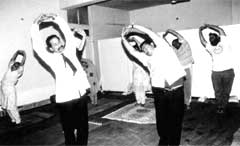Sleep well, old pal
 a team of researchers led by Abby C King and colleagues of the Stanford University School of Medicine, Palo Alto, us, reports that in people between 50 and 76 years with sleep complaints, a regular and moderate-intensity exercise programme can improve their sleep quality (Journal of the American Medical Association (jama), Vol 277, No 1).
a team of researchers led by Abby C King and colleagues of the Stanford University School of Medicine, Palo Alto, us, reports that in people between 50 and 76 years with sleep complaints, a regular and moderate-intensity exercise programme can improve their sleep quality (Journal of the American Medical Association (jama), Vol 277, No 1).
In another study, Walter H Ettinger and his colleagues at the department of internal medicine, Bowman Gray School of Medicine in North Carolina, us, look at the efficacy of a structured aerobic exercise programme on older adults with disability due to osteo-arthritis. Ettinger's study concludes that sufficient improvement in disability, physical performance and pain can be achieved by the inclusion of a moderate exercise regimen as a regular part of the treatment for knee osteo-arthritis.
Considering the simplicity of the studies, anybody would ask: "Didn't we know it already?" In fact David M Buchner from the North West Centre for Outcomes Research Older Adults, University of Washington, in Seattle, us, who wrote the editorial commentary on this set of papers in jama, raised the same question. But he also confessed that these two studies reporting new data have shown how little we know about a seemingly simple issue like the relationship between exercises and sleep quality in senior citizens.
Buchner points out that surprisingly even geriatrics textbooks do not include physical exercise as an area of study for alleviating problems of insomnia in older adults. The hallmark of the study by King and colleagues is its simplicity. They evaluated the impact of moderate-intensity aerobic exercise for 16 weeks in older adults with sleep problems that are not due to any specific illness, which is a common feature at that age. No physiological measurements were taken and the participating volunteers were merely asked to report about the quality of sleep. The exercise regimen consisted of 30 to 40 minute low-impact aerobics and/or brisk walking four times a week for 16 weeks in 29 women and 14 men between 50 and 76 years who were otherwise leading a sedentary life. Significantly, people who exercised took just 15 minutes to fall asleep (as compared to 30 minutes or more in others) and had an extra hour of sleep thrown in as a bonus. Now researchers are looking at how such a simple physical activity could add to the quality of sleep and general improvement in the health of these people.
According to Uton Muchtar Rafei, the regional director of the Southeast Asian Regional Office of the World Health Organization, New Delhi, by the end of this decade, 61 per cent of the world's elderly (about 3,760 million) will be living in the developing countries. In India, by the year 2000, the 60 plus population is expected to touch the 70 million mark.
In India and in many developing countries, a large number of elderly citizens, both in rural and urban areas, are far less conscious of concepts like exercise. Buchner looked for the reasons of insufficient physical activity in older adults, which is reaching almost 80 per cent among women. According to Buchner, when people with arthritis coupled with sleep complaints approach physicians they are given sedative-hypnotic drugs with known adverse effects.
Ettinger's study has not only confirmed the benefits of exercise on arthritis in those aged 60 years and above but has gone beyond. The study has demonstrated that both strength and endurance exercises can be beneficial to such people and that such benefits, which can be sustained over 18 months, are similar across various subgroups like males and females, Caucasians, African Americans, younger and older participants.
While providing some very useful data of practical value to the older people, both the studies suggest newer areas for future study. For instance, if low-impact aerobic exercise can significantly improve the quality of sleep and life in general, it should be worthwhile to work towards designing better and simpler exercise regimens. It will also be useful to find out the optimal time and frequency of exercise per week, so that the quality of life of older adults can be improved. In addition, there is a need to tailor such programmes to work in a community set-up with little or no intervention by physicians.
